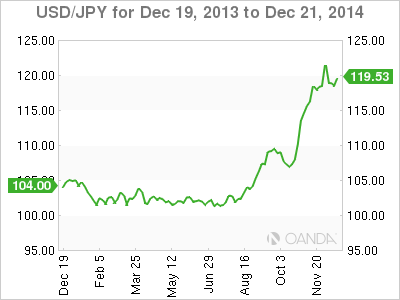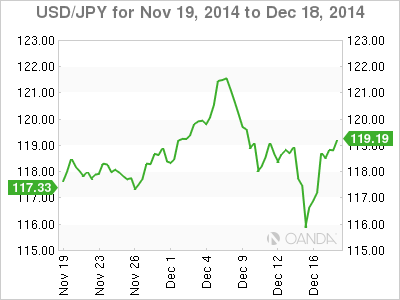Shinzo Abe will end the year with a mixed scorecard. Japan’s prime minister has delivered in terms of weakening the yen as he did in 2013 through the launch of Abenomics. But his struggle to build momentum for his nation’s export-based economy continues. The USD/JPY was trading in a tight range above ¥100 for most of the year. The pivotal event that drove the yen to record lows started last autumn with the end of the U.S. Federal Reserve’s bond-buying program. The $10-billion tapering ended in October, and because of Chair Janet Yellen’s words, the market expects a rate hike in six months’ time. The Bank of Japan (BoJ) did its part to prepare for this eventuality by surprising the markets with a stimulus expansion on Halloween.
Ratings agency Moody’s downgraded Japan’s rating to A1 over uncertainty on its plans to reduce its deficit and boost growth. Moody’s recognized the strength of the Japanese economy, so its downgrade is squarely aimed at Abenomics. Abe called a snap election just as Moody’s increased the political capital of Japanese opposition parties. It wasn’t enough to tip the scale against Abe, but the timing could have been better, as it came one day before the start of the campaign.
Ratings downgrades don’t historically mean a lower currency. Investors tend to look at the overall performance of the economy and developing price action. Economic data out of Japan has been positive of late, but the shadow of the April sales tax hike continues to cast a pall over the island nation’s economy. There were various warnings at the time that while it was the fiscally responsible option, it could drain the momentum kick-started by Abenomics.
The last 30 days have proven to be a rollercoaster for the USD/JPY. After touching seven-year lows versus the USD at ¥121, it quickly moved 400 points, as the price of oil plunged and global growth came under fire. The yen was seen as a safe haven and the inflows pushed the currency down to ¥116. The Fed’s recent announcement of lower rates being maintained until at least March of 2015 resulted in the JPY giving back some of those gains.
A Weaker Currency Alone Is Not Enough
Exports have grown at a faster pace in Japan but not even a weaker yen has been able to significantly change the course of the economy. The main reason for this is that following a globalization and cost-reduction strategy, Japan has outsourced almost a third of its manufacturing. For comparison, in the 1980s only a tenth of Japanese companies manufactured outside of Japan. This shift makes it hard for yen weakness to boost exports overnight, and it reduces the overall impact it can have on the bottom line of corporations.
BoJ Spooked Markets on Halloween
BoJ Governor Haruhiko Kuroda said the central bank is ready to act if needed. According to Kuroda, the soft yen is having a negative effect on the Japanese economy. The yen received a boost after the BoJ minutes showed that some policymakers opposed the BoJ’s decision to expand its stimulus program in October. At that time, the BoJ shocked the markets when it increased its government debt purchases from ¥60–70 trillion to ¥80 trillion per year. The division within the BoJ could make it harder on Kuroda to introduce further stimulus. The governor stressed the need to act now, and the measure is seen as a pre-emptive move to prevent Japan from losing even more momentum after the April sales tax hike.
Japan Needs Reforms to Benefit from a Weaker Yen
Abenomics is based on “three arrows” of fiscal stimulus, monetary easing, and structural reforms. So far, Abe has aimed and shot two of them to mixed results. The BoJ unleashed quantitative easing to stimulate the economy, promote consumer spending, and fight deflation. At worst, the increased sales tax cancelled out the effect of the first arrow. At best, the subsequent lull in Japan’s fortunes is transitory. The third arrow (structural reform) has been promised time and again, but in practice it is the hardest to deploy. Reforms that could unlock the labor market and open Japan to more trade are not welcomed by unions and lobbies of the industries that will be affected. Japanese corporations have pledged that if reforms do come to fruition, then they will do their part with higher wages. Some of the pieces have been put in place, and Abe’s landslide election win should put him in a better place to push the much-needed reforms through.
Japan Faces Uphill Battle in 2015
Next year will be challenging and not just for Abenomics to reach its lofty goal of 2% inflation, but Japan as a whole to navigate the turbulent waters spiked by slower global growth. The Trans-Pacific Partnership still faces many obstacles to become a reality. Japanese unwillingness to negotiate certain issues is a big part of it. The U.S. and Japan could stand to gain the most from this far-reaching agreement, but they are also the ones that have the higher number of protectionist requests to limit the impact of the proposed deal. After the increase of factory outsourcing and the lower exports to China, the Japanese economy needs to increase exports that will benefit from a weaker currency, as opposed to those in shrinking markets or where costs have gone up due to a depreciating yen.
Recommended Content
Editors’ Picks
EUR/USD clings to daily gains above 1.0650

EUR/USD gained traction and turned positive on the day above 1.0650. The improvement seen in risk mood following the earlier flight to safety weighs on the US Dollar ahead of the weekend and helps the pair push higher.
GBP/USD recovers toward 1.2450 after UK Retail Sales data

GBP/USD reversed its direction and advanced to the 1.2450 area after touching a fresh multi-month low below 1.2400 in the Asian session. The positive shift seen in risk mood on easing fears over a deepening Iran-Israel conflict supports the pair.
Gold holds steady at around $2,380 following earlier spike

Gold stabilized near $2,380 after spiking above $2,400 with the immediate reaction to reports of Israel striking Iran. Meanwhile, the pullback seen in the US Treasury bond yields helps XAU/USD hold its ground.
Bitcoin Weekly Forecast: BTC post-halving rally could be partially priced in Premium

Bitcoin price shows no signs of directional bias while it holds above $60,000. The fourth BTC halving is partially priced in, according to Deutsche Bank’s research.
Week ahead – US GDP and BoJ decision on top of next week’s agenda

US GDP, core PCE and PMIs the next tests for the Dollar. Investors await BoJ for guidance about next rate hike. EU and UK PMIs, as well as Australian CPIs also on tap.

